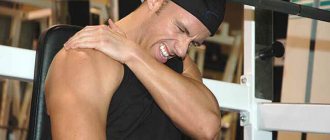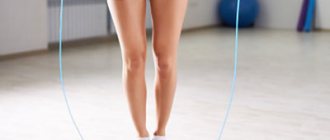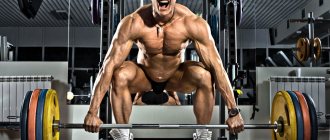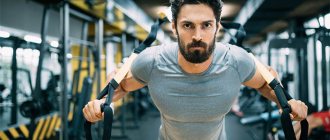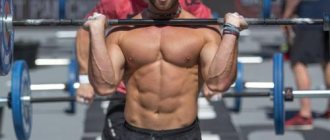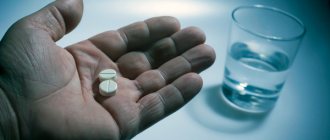Text: Karina Sembe
Sports have long been an important part of life: training uniforms have penetrated into street fashion, and in conversations at an exhibition or in a bar you can increasingly hear words like “hyperextension” and “cheat meal”. Fitness terms are used not only for the sake of a catchphrase: training programs are entirely supersets and drop sets, and even the instructions of an aerobics instructor seem vague at times. There is a need to find out what the most common words in sports jargon mean. It’s not a fact that the jokes of amateur bodybuilders about gaining mass will now seem funny, but it will certainly become clearer what the coach is talking about.
↑ Burpee
Anaerobic load
Exercises with short-term effort, when energy is produced not from oxygen supplied to the muscles with the blood, but from the reserve of “fuel” substances in the muscles. True, after 8–12 seconds the body begins to use oxygen and the exercise becomes aerobic (hence the popularity of interval anaerobic training, in which each set is followed by 8–20 seconds of rest). Anaerobic exercise predominates in powerlifting, bodybuilding, and sprinting, while aerobic exercise predominates in long-term endurance training, from cycling to cardio training and aerobics itself.
Hello! This time I decided to make your fuss easier and compile a small dictionary of basic bodybuilding terms.
It will be constantly updated, compiled spontaneously from memory, and therefore not in alphabetical order. So don’t forget to press Ctrl+F and enter the words of interest.
Aerobic (loads, exercises) – long-term physical activities of low intensity, aimed mainly at the development of the respiratory and cardiovascular systems.
Antioxidants are substances that prevent oxidation and breakdown of tissue, both muscle and other.
Estrogen is a female hormone that has a detrimental effect on the physical fitness of the body.
A superset is a set consisting of several types of exercises.
Bodybuilding - consists of two words: body (body) and build (build), the semantic translation is body building.
Hormones are active substances produced by glands and released into the blood. Regulate body functions.
Amplitude – (in BB) the length of the movement when performing an exercise.
An isolation exercise is an exercise that mainly works only one muscle, or part of it.
A set is several approaches combined with identical pauses.
Casein is a protein found in animal products such as milk.
A set is a series of repeated movements consisting of contracting the muscle(s) and stretching, in bodybuilding, usually 6-12.
Anaerobic (loads, exercises) - means short-term and intense physical activities.
Glycogen is an analogue of glucose, fuel for muscles, which is used in case of lack of external carbohydrates.
Androgenic is a synonym for “male”, a characteristic that corresponds to the male genital organs and the male hormone - testosterone.
Split is a training scheme that involves dividing muscle groups by day, that is, different groups on different days, and alternating.
Failure - for example, “press to failure” means doing an exercise until the next movement is impossible, that is, the muscles can no longer perform the work with this weight, so to speak, “with all their might to the end.”
Metabolism is the balance of catabolism and anabolism in the body, the combination of these factors determines the metabolic rate.
A training program is a system of exercises consisting of physical actions divided by days, muscle groups, sets and approaches.
Atrophy is a decrease in physical muscle strength and volumetric indicators.
Anabolism is the process of accumulation and absorption of external substances by the body, weight gain (both muscle and fat).
BCAA – amino acids leucine, valine, isoleucine. Prevents catabolic processes.
Amino acids are substances that contribute to the structure of proteins.
Drop set - a set with a gradual decrease in loads for the smoothest possible failure, mainly used to achieve muscle relief.
Catabolism is the process of destruction of tissue in the body (both muscle and fat).
Testosterone is a male hormone responsible, among many other things, for the development of lean body mass.
EZ – barbell – a barbell with a curved bar. Prevents damage to the tendons of the hands when performing biceps curls.
Circuit training (CrossFit) is a set of exercises consisting of 1 approach each and no pause between them. For example: pull-ups + push-ups + running + jumping + pull-ups (and again).
Steroids are additional elements that help retain protein in the muscles. All have a number of side effects that are dangerous to organ health.
The Scott bench is a bench that has a support for the arms (from the elbow and above), designed for effective biceps training.
Blocks are stationary exercise machines based on the use of cables and weights attached to them.
Basic exercises are exercises that, when performed, load a large muscle group and do not place stress on a specific muscle.
Phil
Gainer
(English gain - to extract, receive)
A sports nutrition product with a high content of carbohydrates (simple or complex) and some protein, which is used to gain muscle mass: carbohydrates are the best fuel for physical activity in the gym, and protein is an essential building material for muscle growth.
↑ Deltas
Crunch
(English: crunch)
The fashionable name for good old abdominal exercises comes from the English language. The literal meaning of the word crunch is “crack”, “crunch”, but with the correct technique, crunch should not be accompanied by either a crack or a crunch: lifting and/or twisting of the upper body is performed not by inertia, but by muscle contraction.
↑ Hitch
Refusal
Something to which it is not at all necessary to bring the training, even if the trainer advises the opposite. We are talking about working “all the way”, that is, until the moment when it seems that there is no strength for the next repetition of the exercise: the neurons are damaged and lose the ability to transmit an electromechanical impulse. Withdrawal training reduces plasma insulin-like growth factor (IGF-1) levels, increases cortisol production, and can damage the endocrine and nervous systems in the long term.
Dictionary
A short dictionary of obscure words. Some of the descriptions are borrowed from the vocabulary of Joe Weider's Body Building System. Just so as not to invent definitions again...
A
ANABOLISM
(gr. anabole - rise) - a set of metabolic reactions in the body corresponding to assimilation (assimilation and accumulation of substances external to the body) and aimed at the formation of complex organic substances, for example muscle fibers (opposite - CATABOLISM).
ANDROGENS
(Gr. andros - man, genos - genus) - chemical substances that act in the body like the male sex hormone - TESTOSTERONE.
Accordingly, ANDROGENIC - characterized by male sexual characteristics - the structure of the skeleton, muscular system, etc.
ANAEROBIC EXERCISES -
strength training. “Anaerobic” means “without oxygen” and involves brief, short intense bursts of energy.
AMPLITUDE OF MOTION —
the length of the trajectory of the projectile in exercises.
AROMATIZATION
(eng. aromatizing) - the conversion of testosterone into estrogen, the body's natural reaction to increasing testosterone levels. It is not a fixed amount of T that is converted, but a percentage of the total amount of T in the body; the more testosterone, the more estrogen. The term is used to characterize an anabolic steroid by its ability to cause a number of side effects, gynecomastia, for example.
Atrophy-
reduction in muscle volume and strength level.
Aerobic exercise-
long exercises performed with the participation of large muscle groups. The heart rate is increased for a sufficiently long time to provide a training effect on the respiratory and cardiovascular systems.
B
Bandages-
safety bandages wrapped around the knees during squats.
Blocks-
devices with pulleys and cables attached to weights for use in exercise.
Blocks for crossing arms -
a special device for working out the inner sections of the chest by pulling the handles of the blocks from the position of the arms spread out to the sides and up to the position where they are crossed in front of the chest.
Block traction machine-
a machine where you sit or kneel and pull the handle down towards your chest or behind your head (developing the latissimus muscles).
IN
"Explosion"-
degree of extreme muscle development.
Shutdown-
part of the amplitude in which the load on the muscle sharply decreases due to its transfer to other muscles involved in the work.
Endurance-
the ability of a muscle to develop sustained forces over a period of time.
Exit to "peak":
- denote any situation in an exercise in which you achieve maximum isolation of a single muscle. For example, you do precise, concentrated bent over curls to achieve a peak in your biceps;
- preparation for competitions.
G
Head straps-
a device made of belts and a chain worn on the head, having a device for attaching weights; used in exercises for neck muscles.
HORMONES
(gr. - hormaino - set in motion, encourage) - otherwise hormones, physiologically active substances produced and released into the blood by the endocrine glands and involved in the regulation of the functions of the animal body.
GYNECOMASTIA
- the formation and development in the male body of tissues similar to the tissues of the female mammary glands. Develops under the skin between the pectoral muscle and the nipple. Occurs when the overall level of estrogen in the body increases, for example, as a result of aromatization.
“Gynecomastia, or “bitch tits,” is the development of female breasts in men. Gynecomastia is a very common side effect of anabolic steroid use. Every male body naturally produces small amounts of estrogen, a female hormone. When using anabolic steroids, estrogen levels increase and may even become dominant.
Some anabolic steroids are especially prone to converting to estrogen. When using these steroids, the levels of both male and female hormones increase. High levels of estrogen sooner or later cause the development of gynecomastia in most people.
Abruptly stopping steroid use greatly increases the chances of developing gynecomastia. The use of anabolic steroids causes testicular shrinkage, inactivity and atrophy. Normal testicular function usually returns after steroid use is stopped, but full recovery of testicular size and function may take several months. When you suddenly stop taking steroids, there is a point when the level of anabolic hormones is very low. The testicles have not yet restored normal testosterone production, and hormones are not supplied from the outside. As a result, estrogen may become dominant and gynecomastia will almost certainly develop.
Gynecomastia can be avoided if you use anti-estrogens such as Nolvadex or anabolic steroids that are not prone to conversion to estrogen.”
Gravity boots-
(inversion boots), shoes with hooks that allow you to hang upside down to stretch the muscles and tissues of your back.
Breast machine-
device for developing pectoral muscles.
Breast-
abbreviated name for the pectoralis major and minor muscles.
D
Deltas, Deltoids-
Abbreviated name for the deltoid muscles.
E
E-Zed-vulture
(bent bar) - a special bent bar for ease of working out biceps and triceps.
AND
Body fat
the level of fat deposited in the body.
Z
Final posing-
performance by athletes of a freestyle program, taking place in conditions of fierce competition.
AND
Go to the maximum
overcoming the maximum amount of weight in one repetition.
Isokinetic exercise:
- exercise with varying resistance along the movement, changing in different parts of the amplitude;
- exercise with a constant speed of weight movement.
Isometric exercise-
tension of the muscle while maintaining its constant length, the limbs do not move. These exercises are usually performed against a wall or some stationary object.
Isotonic exercise-
work of a muscle, during which its length and the amount of burden change, but the tension remains constant;
Lifting free weights is a classic example of isotonic exercise.
Intensity:
- the degree of effort put into training;
- percentage of the maximum training weight of the equipment.
TO
Cardiovascular
(cardiovascular)
training -
physical exercise that strengthens the heart and lungs.
"Pumping Iron" -
the term, which appeared in everyday use in the 50s and became very popular, refers to exercise with weights.
CATABOLISM
(gr. katabole - throwing down) - a set of metabolic reactions in the body consisting of the breakdown of complex organic substances, such as muscle fibers, with the simultaneous release of energy, which is used in the vital processes of the body (opposite - ANABOLISM).
Kinesiology-
the science of muscles and the movements performed with their help.
Contest-
athletic competitions in the freestyle program.
Circular training-
a long session with immediate transition from one exercise to another.
L
Straps-
special bands attached to the hands and to the barbell to ensure a secure grip during pulling exercises.
M
Magnesia-
powder that is applied to the palms to ensure a secure grip on the projectile.
Mats-
special bedding for exercise.
METABOLISM
- the general name for the totality of metabolic processes in the body, consists of ANABOLISM and CATABOLism.
Mental approach-
setting a task and positive concentration on its upcoming implementation.
Muscle tone-
a condition in which the muscle is in constant slight tension and appears tight.
N
Inclined board-
bench for abdominal training.
Increasing volumes -
heavy training and eating high-carbohydrate foods to constantly increase weight and muscle mass.
National Championship-
top-level amateur women's and men's competitions in four weight categories.
UNREFINED
, or LONG, CARBOHYDRATES - so-called. polysaccharides, which include various starches (rice, bananas, potatoes), fiber from grains, legumes, vegetables and fruits. They are characterized by a long period of breakdown and a constant supply of energy to the body.
P
"Burnout" -
state of nervous and physical fatigue (overtraining).
Gloves-
used to protect the palms and securely grip projectiles.
Plyometric exercises-
exercises in which muscles are suddenly loaded and stretched and then quickly shortened. To perform them, athletes must, say, jump off a bench and quickly jump onto another bench.
Mobility
(range of motion), ability to stretch muscles and mobility in joints.
AN APPROACH -
a set of movements in an exercise performed continuously until failure. For example, I lay down on a bench, did 8 chest presses without a break, broke down, put the barbell in place - this is the approach.
Striping-
high degree of muscle relief, their linear “striations”.
Sweat-retaining tapes-
bands made of cotton fabric worn on the wrists or forehead to absorb sweat during training.
Stretches-
tears (light scars) in the skin caused by faster growth of muscle or fat tissue compared to the increase in skin surface area.
Push-up belt-
A wide, strong belt around the hips with a chain that can be attached to a barbell disc or dumbbell for added weight during certain exercises, such as dips.
Press-
Abbreviated name for the abdominal muscles.
Program-
a set of approaches and repetitions performed sequentially in each lesson.
R
Warm-up-
a series of exercises that increase blood circulation in preparation for training.
WITH
Free weights-
dumbbells and barbells (as opposed to exercise machines).
Leg Curl-
exercises lying on your stomach, bringing your heels to your buttocks, overcoming resistance (to strengthen the hamstrings).
SET
- the English analogue of our concept of “approach” (see).
Force-
the ability of a muscle to develop a certain amount of force.
Symmetry-
body shape or outline, balance of bone and muscle structure.
Scott Bench-
isolating bench for bending the arms (almost vertical support for training the arm muscles).
Back-
Abbreviated name for the latissimus dorsi muscles.
Middle sections-
abdominal muscles, including the upper and lower abdominals, obliques and other abdominal muscles.
Tendon-
a band (or cord) of strong fibrous tissue that attaches muscle to bone.
STEROIDS
- a group of organic substances of plant and animal origin, including sterols, vitamins D, sex HORMONES, hormones of the adrenal cortex, as well as various cardiac glycosides, etc.
SMITH MACHINE
- bench press or squat machine. It consists of two vertical guides in which the bar moves during the exercise. Limits the freedom of the projectile to oscillate back and forth. There is a variation of the Smith machine for the squat, similar to the leg press machine, only the person in this machine is positioned in a natural position - feet down.
T
TESTOSTERONE
(Latin testiculus - male testicle) is a male sex hormone, formed in the male gonads (testes) and determines the formation of male genital organs and the development of secondary male sexual characteristics; By chemical nature it belongs to STEROIDS. In medical practice, a lot of derivatives are used, for example METHYLTESTOSTERONE and TESTOSTERONE PROPIONATE.
Trapezoid-
Abbreviated name for the trapezius muscles.
Training "to failure" -
performing the exercise until you are no longer able to perform the subsequent repetition.
Training belt-
protective equipment that is worn on the abdominal area to support the back, say, in bench presses, squats, deadlifts, etc.
Training effect -
increasing the functional ability of muscles as a result of increasing load applied to them (progressive overload).
TAPERING
(English, special, slang tapering) - a slow decrease in the amount of steroids taken, allows the body to smoothly adjust to normal, natural work when exiting the steroid cycle. It can be thought of as a ladder along which you first climbed God knows where (into the jungle of the anabolic cycle), and then slowly descend back to normal life.
U
Calming exercises
(cool-down), a series of light, partly aerobic exercises, as well as stretching, that complete the workout. Cooling down gradually reduces the load on the heart.
Shin warmers-
equipment worn on the lower leg to keep it warm.
F
Fascia-
fibrous connective tissue that covers, supports and separates all muscles and muscle groups; connects the skin to the underlying tissues.
Flexion-
muscle tension.
ENZYMES
(Latin fermentum - leaven) - complex organic substances of a protein nature, contained in animal and plant organisms and accelerating chemical processes in them millions of times; play a vital role in metabolism.
Form:
- characterizes the degree of muscle formation, their fullness and roundness;
- balance between muscles and bones.
Forced reps-
performed with the help of a partner to complete the last couple of repetitions in the set at the limit of strength.
SCH
Ankle weights-
special weights attached to the ankle and providing additional weight in exercises involving the legs; Can be attached to the wrists to intensify hand exercises.
E
ENDOGENOUS
- internal origin, produced by the body naturally.
ENZYMS
(gr. en - inside, zyme - leaven) - the same as enzymes.
ESTROGEN
- female sex hormone.
I
Buttocks-
abbreviated name for the gluteal muscles (small, medium and large).
Protein
In the world of fitness, it is a sports nutrition product based on protein mixtures that serves to reduce body fat, stimulate muscle growth and maintain physical fitness. Depending on goals and preferences, they use whey, egg, soy, rice or other protein with different flavors. In addition to protein powder, there are not only familiar bars on sale, but also protein yogurts, cereals and even ice cream.
↑ Weighting
Cheating
(English: cheating)
A technique in bodybuilding and powerlifting in which the weight of the apparatus in the positive phase of movement, that is, in the phase when muscle contraction occurs, moves from the engaged (and tired) muscle group to other, not fatigued ones. Cheating is also called certain “loading days”, when the usual amount of calories consumed is 50–70% higher in order to “hint” the body that it does not need to store energy reserves in the form of fat. According to many nutritionists, situational overeating, including cheat meals, is not good for the digestive system.
Photos: Nike Pro Bra, Dear Kate/Facebook, Nike/Instagram (1,
Basic terms in fitness: what a beginner should know
Share
The development of fitness does not stand still, new directions are emerging and stable terminology is being formed. If you still confuse catabolism with anabolism and don’t remember what a superset is, then this article is for you.
As in any society, the field of fitness has its own terminology. Trainers and gym visitors love to exchange words that only they understand. We will not burden you with scientific terms, but will try to explain what is what in fitness and how it can help you.
Hormonal processes in the body
Anabolism
The process of creating new tissue is part of the body's metabolism, which occurs constantly. But it’s up to you to decide what kind of tissue to create – fat or muscle. To create a beautiful muscle definition, exercise regularly and burn calories.
Catabolism
This is the opposite process to the previous one. The process of breaking down tissue to produce energy. For example, during training, fat reserves are burned. However, under too much stress or lack of food, the body can break down energy-intensive muscle tissue, and the excess goes into fat reserves. Therefore, it is important not to put the body into a state of stress.
Cortisol
This is a hormone involved in catabolism. It perfectly helps to cope with stressful situations (fire, flood, sports). But it produces energy from muscle tissue and negatively affects the condition of the heart and blood vessels. To maintain it at an optimal level, do not skip meals and do not overload yourself in training, get enough sleep.
Somatotropin
This is growth hormone. Despite the scary name, it's quite useful. It helps renew and rejuvenate the body's cells, using energy from the breakdown of fat reserves.
Testosterone
This is the main anabolic hormone. It helps build muscle and burn fat. It also improves mood and self-confidence. Some girls are afraid to pump up. In fact, it is very difficult to do this. Not all guys can boast of developed muscles, but they have 20 times more of this hormone.
Training loads
Anaerobic
This type of exercise includes any intense training in which the body uses glycogen for energy without the participation of oxygen. That is, the workouts are so hard that you involuntarily have to hold your breath. Both strength exercises and sprints can be anaerobic. These workouts help strengthen joints and bones and normalize hormone levels. They also speed up metabolism, including after training.
Aerobic
This is a type of training in which the body converts energy using oxygen. For example, long runs during which you breathe deeply and evenly. It's a great workout if you don't do it for too long. This is harmful to the joints, and is also perceived by the body as stress, which slows down metabolism, cortisol levels increase and muscle tissue begins to decrease instead of fat.
However, in moderation, exercise is very beneficial for the heart, blood vessels and respiratory system. Therefore, it is worth conducting such training after strength training or on rest days.
Interval load
A workout consisting of both anaerobic and aerobic exercise. This allows the body to quickly use up glycogen and begin to store fat. Which contributes to faster calorie consumption at the same time. However, such training requires much more effort and is best not combined with purely strength exercises.
Circuit training
It involves performing several exercises in a circle without a rest break. The exercises are performed several times, after finishing the circle you can take a break and start over.
This type of training is great for those who have little time but a lot of free exercise equipment. As a result, you won’t be able to increase your strength and mass much, but you can lose weight and burn fat reserves.
Repeat – performing a certain exercise once.
Approach (set) – several repetitions of one exercise. In training programs, the number of approaches and the rest time between them are always indicated. If there are few approaches and the weight is heavy, then this will develop strength and increase muscle size. If there are many approaches and the weight is average, then this develops endurance and allows you to quickly lose weight.
Superset
Performing several exercises on one muscle group without a break. Used to pump up the muscles in this area. For example, if you want to pump up your gluteal muscles, but nothing helps, try a set of glute bridges and sumo deadlifts. For the triceps, a set of arm extensions on a block machine and barbell presses with a narrow grip will help.
Exercises
Multi-joint
These are exercises that involve several muscle groups and joints. These are basic exercises such as deadlifts, squats and lunges.
Single-joint
These are simpler exercises that work only one joint and one muscle group. What are they used for?
- If the basic exercise cannot be performed for some reason, a single-joint exercise for these muscles comes to the rescue.
- Also, simple exercises can be combined into supersets for maximum muscle pumping.
- Single-joint exercises are great for circuit training because they are easy to perform and don't require concentration.
